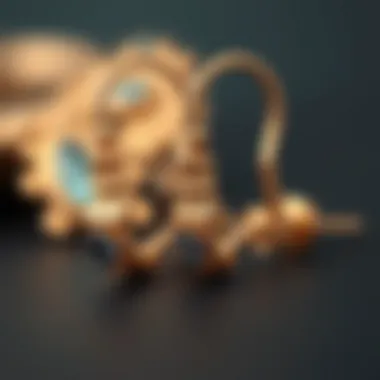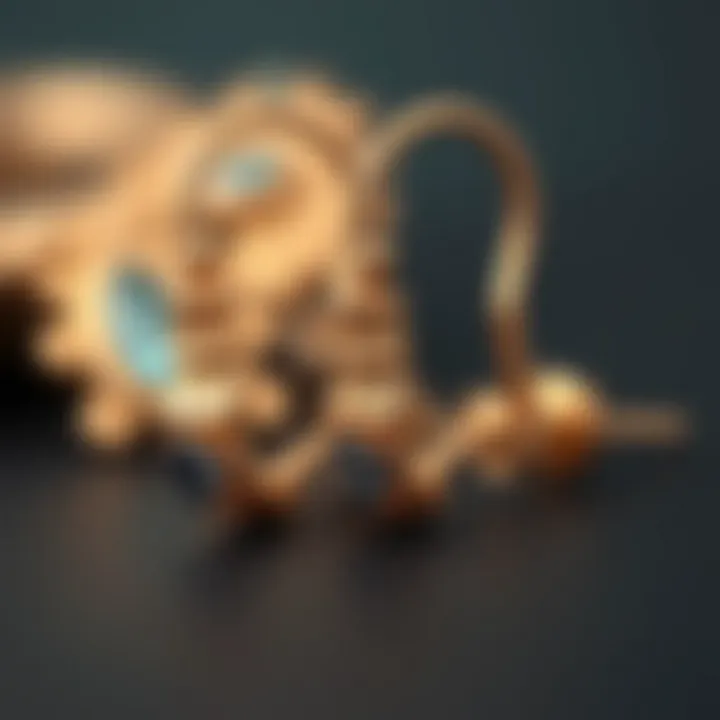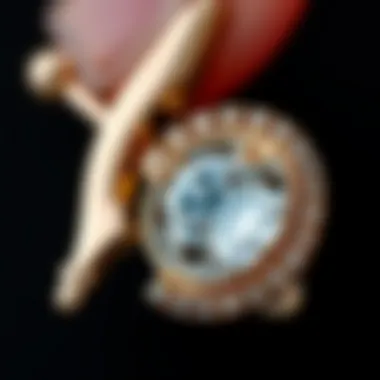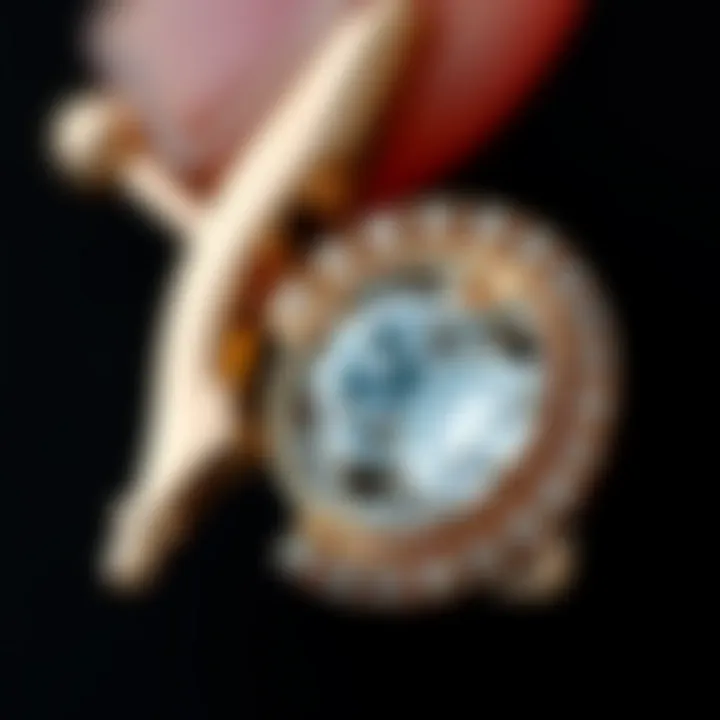Exploring Leverback Earring Findings in Jewelry Design


Intro
Leverback earring findings have quietly carved out a niche in the jewelry crafting world, bridging elegant design with practical functionality. For those who may be new to this type of earring finding, it’s essential to recognize their distinguishing features. Leverback earrings are not just about how they look, but also how they secure the entire piece. Their unique mechanism combines a hook and a lever, which helps prevent them from falling out during daily activities. This feature alone has made them a favorite among jewelers and wearers alike, particularly those who seek both beauty and reliability.
In addition to functional advantages, leverback earrings come in various materials and designs, allowing for a wide range of artistic expression. From stunning sterling silver to robust gold and intricate designs adorned with gemstones, the variations are nearly limitless. With the jewelry market continually evolving, understanding these findings is as important as knowing the materials they are made from or the designs they embody. This article delves into the multifaceted world of leverback earring findings, offering insights into their design, material choices, functional relevance, and emerging trends.
By the end, both novices and seasoned crafters will have a thorough understanding of these key features, fostering a deeper appreciation for their place in the jewelry landscape.
Understanding Leverback Earring Findings
Leverback earring findings, often overlooked staples in the jewelry-making toolkit, are much more than mere connectors. These fasteners bring not just utility but also aesthetic charm to earrings, making them a preferred choice among both jewelry enthusiasts and professional crafters. Knowing the ins and outs of leverback findings significantly enhances the design and functionality of earrings. Let's delve deeper into this art form through two essential facets: defining the findings and exploring their historical backdrop.
Definition and Overview
At their core, leverback findings are a particular style of earring closure that combines a hook mechanism with a secure latch. When closed, this design creates a reliable and snug fit that helps prevent earrings from slipping off the ear. The mechanism is composed of a long wire that arches into a hook and pivots to fasten securely against the back of the earlobe.
This unique structure not only maximizes security but also enhances wearing comfort. Leverback styles can vary in thickness, length, and embellishments, allowing for a range of personalization. They are often favored for their versatility, suitable in both casual settings and more formal jewelry pieces.
"Leverback earrings blend sophistication with practicality, making them ideal for any occasion."
The growing trend towards lightweight and comfortable jewelry has popularized leverback findings considerably. Consequently, understanding the nuances of these findings empowers artisans to make informed choices in their earring designs, ultimately leading to creations that are not only beautiful but also functional.
Historical Context
The history of leverback findings is intriguing, intertwined with the evolution of jewelry across cultures. While the exact origins are difficult to pinpoint, similar fastening methods can be traced back to ancient civilizations. For instance, early Romans and Greeks made use of primitive hook-and-loop mechanisms in their jewelry creations.
During the Renaissance period, advancements in metalworking paved the way for more refined earring designs, with leverback styles emerging as practical solutions to ensure that precious pieces stayed in place throughout daily activities. This effectiveness did not go unnoticed; artisans began to embrace the design, leading to its wide proliferation in European jewelry.
By the 20th century, various design innovations had freshened the leverback's look, incorporating decorative elements and combining materials in ways that had not been previously explored. Today, leverbacks are available in an array of artistic forms, representing both historical significance and modern trends. This fascinating evolution underlines their functional enhancements and their continual relevance in contemporary jewelry making.
Design Features of Leverback Findings
When it comes to leverback earrings, the design features play a pivotal role in both aesthetics and functionality. Understanding these elements enables jewelers and enthusiasts alike to appreciate the craftsmanship involved. This section will delve into the anatomy of leverback earrings, highlighting the specific components that make them a preferred choice in the jewelry world.
Anatomy of a Leverback Earring
Hook Mechanism
One of the standout features of a leverback earring is its hook mechanism. This unique design not only adds to the elegance of the earring but also provides a user-friendly way to secure it in place. The key characteristic of this feature is its ability to gently but effectively latch onto the ear, preventing accidental slips.
The hook mechanism’s design eliminates the need for additional clasps that can be cumbersome or fiddly. Its simplicity is a significant factor in its popularity. However, it is essential to consider that the hook needs to fit properly into the ear to avoid discomfort. A well-designed hook can enhance the overall experience of wearing the earring, ensuring it is easy to put on and take off.
Back Closure
Another crucial aspect of leverback earrings is the back closure. This part of the design serves as a safety measure, preventing the earrings from falling off while maintaining style. The back closure works by folding down and locking into place, making it harder for the earring to dislodge. The smooth design of this closure allows it to sit comfortably against the skin without causing irritation.
However, selecting the right fit for the back closure can be a matter of personal preference. While some individuals favor a snug fit, others might prefer a bit more wiggle room. Therefore, jewelers must keep in mind the varied needs of wearers when crafting these earrings.
Post and Loop Design
The post and loop design is another defining feature of leverback earrings. This configuration is relatively straightforward, allowing for easy insertion into the ear. Many consider this system a beneficial option due to its seamless integration into the overall earring structure.
The key characteristic here lies in its simplicity, which balances aesthetics with practicality. The loop connects seamlessly to the earring, ensuring that it hangs properly while also providing a secure fit. One advantage of this design is that it can accommodate a variety of earring styles, from simple studs to more intricate designs. However, it may not suit everyone's ear shape, so it's wise for manufacturers to provide different options to cater to diverse preferences.
Varieties in Design
Classic Styles
Classic styles in leverback earrings are timeless. They offer a blend of traditional elegance and contemporary flair that appeals to a wide audience. The hallmark of such styles lies in their versatility; whether adorned with gemstones or left minimalist, they can transition from daywear to evening attire effortlessly.
What makes classic styles a favored choice is their endurance in fashion trends. They don’t go out of style easily, which can be an appealing factor to both buyers and creators. On the downside, one might argue that too much adherence to classic designs may stifle creativity in some instances.
Decorative Elements
Incorporating decorative elements into leverback earrings allows for personal expression and style variation. From intricate filigree to bold gemstone settings, these elements can transform a simple earring into a statement piece. The appeal of decorative features is scalable; whether bold or subtle, they offer something for every taste.
However, adding excessive ornamentation could weigh the earring down or create a mismatch with clothing styles. Designers must strike a balance between decoration and wearability to ensure that the earrings remain attractive while not compromising the comfort level of the wearer.


Custom Designs
Custom designs are where creativity truly flourishes in the world of leverback earrings. Jewelers have the opportunity to combine different materials and aesthetics, crafting unique pieces that reflect personal or meaningful themes. The distinctive characteristic of custom designs is their exclusivity, as they are often tailored to individual preferences on elements like size, color, and material.
Creating a custom design allows jewelers to develop something truly unique, which can capture the essence of a special occasion or sentiment. Nonetheless, this can come with higher costs. Custom pieces might not be as accessible for everyone, but for those who can invest, they often become cherished keepsakes.
Leverback earring findings are not just accessories; they encapsulate artistic vision and individual style.
Culmination
The design features of leverback findings play an integral role in their enduring appeal in the jewelry world. Each element, from the hook mechanism to decorative touches, contributes uniquely to the overall function and style. Understanding these facets not only helps consumers make more informed choices but also guides designers in creating pieces that resonate with this sophisticated audience.
Functional Aspects of Leverback Findings
The essential role of leverback earring findings extends beyond mere aesthetics; it speaks to the very fabric of their functionality. In a thriving jewelry landscape where craftsmanship meets innovation, understanding the functional aspects of leverback findings can illuminate their significance and advantages. These characteristics help jewelers and consumers alike make informed decisions when choosing earrings, highlighting the blend of style and practicality.
Advantages of Leverback Findings
Secure Fit
Leverback earrings are often lauded for their secure fit. This feature is primarily owing to the locking mechanism that keeps the earring in place, preventing unwanted slips. Unlike other earring styles, which might sway with movement or get caught on clothing, a leverback design hugs the earlobe closely, offering peace of mind to wearers who lead active lives.
Additionally, this reliable closure is particularly beneficial for those who may have younger kids or enjoy outdoor activities. Knowing that the earrings won’t fall off with every head shake makes them a popular choice for everyday wear. On the flip side, the tightness might feel slightly restrictive for some, a small trade-off for the overall security they provide.
Ease of Use
When it comes to ease of use, leverback findings allow for effortless wearability. The design facilitates simple opening and closing; a gentle press typically suffices to pop them open, which is a blessing during hurried moments when time is of the essence. This user-friendly approach is highly valued, especially in a fast-paced world where convenience reigns supreme.
Nevertheless, if someone struggles with fine motor skills or dexterity issues, they might find these mechanisms slightly tricky at first. However, familiarity can quickly breed comfort, making it easier to navigate this design successfully over time.
All-Day Comfort
Comfort is another unbeatable advantage that leverback earrings bring to the table. Their design often features a lightweight construction. Therefore, they can be worn for extended periods without an ache or fatigue setting in. All-day comfort makes them a favorite among professionals and fashionistas alike who can go about their work or social occasions without dealing with nagging discomfort.
The curve of the leverback fits snugly against the ear, preventing the earring from poking or jabbing in unwanted ways. However, it’s essential to consider the overall weight of the earring itself. Heavier embellishments may offset this balance, resulting in some strain on sensitive ears.
Potential Drawbacks
While leverback findings are often viewed through a rose-tinted lens, they are not without their potential drawbacks, which warrants careful consideration.
Weight Considerations
One significant weight consideration arises from the material used in crafting leverback earrings. While lighter metal options such as sterling silver or gold-filled materials typically favor comfort, some jewelers might choose heavier materials for dramatic effect. This choice can lead to fatigue over prolonged wear.
A heavy earring may also lead to potential stretching of earlobes over time. Hence, those prone to allergic reactions or skin sensitivities should be aware of the materials used within the leverback closures too. In a nutshell, while aesthetic appeal is key, practicality should not be overlooked when selecting weightier designs.
Compatibility with Designs
Another point of caution is the compatibility with designs. Leverback mechanisms won't suit every earring style. For example, they do not align well with intricate designs such as those requiring a thread-through closure or other unique fastening methods. This incompatibility can limit creativity in earring design, particularly in trendy or avant-garde pieces.
Moreover, if one opts for a leverback finding while seeking an elegant chandelier style, one might end up compromising the overall visual flow of the piece. Therefore, it’s vital to assess whether leverback findings fit the desired jewelry design before diving into production or purchase.
Employing leverback earring findings can be a fantastic choice, blending security, ease, and comfort. Yet, potential drawbacks like weight issues and design compatibility necessitate thoughtful examination, ensuring that every piece serves both function and style effectively.
"Choosing the right earring finding is as crucial as selecting the gemstone itself; both should resonate with the wearer’s lifestyle and taste."
As such, balancing aesthetics with function can lead to delightful jewelry choices that satisfy both form and utility.
Materials Used in Leverback Earring Findings
Understanding the materials used in leverback earring findings is crucial for both the creator and the wearer. Materials not only affect the look and feel of the earrings but also their durability and comfort. Choosing the right materials leads to an enhanced experience and satisfaction, as it positively impacts the overall quality and performance of the jewelry. Here we delve into the various materials, their properties, and how they fit into the broader context of jewelry making.
Common Materials
Metal Types
Metal types are often the stars of the show when it comes to leverback earrings. They’re known for their strength and ability to hold the structure of the findings. Most notably, sterling silver and gold are widely appreciated for their aesthetic appeal and inherent value. Sterling silver, with its brilliant shine, not only draws the eye but also provides a decent level of durability. Gold, whether it's yellow, white, or rose, holds its value and resists tarnishing better than many other metals.
A key characteristic of metals is their malleability, which allows jewelers to craft intricate designs. Furthermore, the unique feature of metals lies in their resistance to corrosion, making them suitable for daily wear. However, one must consider the potential for skin reactions, especially for those with allergies to nickel, commonly found in less pure metals.


Plastics and Composites
Plastics and composites are becoming increasingly prominent in the jewelry scene, especially in leverback findings. They offer a lightweight and affordable alternative compared to traditional metals. A significant advantage of using plastics is their versatility in color and design. You can find a myriad of shades and patterns that can’t be achieved with metal alone. These materials can cater to a younger demographic or those who prefer bright and playful designs.
Yet, they do not carry the same prestige as metals, which might deter some buyers. The major downside is susceptibility to wear over time, with scratches or fading, which can undermine their appeal in long-term use.
Organic Materials
Organic materials like wood, shells, or even resin have made their way into modern jewelry design, providing a vast canvas for creativity. One of the main virtues of organic materials is their eco-friendly nature, appealing to those who value sustainability. Materials such as bamboo or sustainably sourced wood not only look stunning but also resonate with the growing trend of eco-conscious living.
A unique feature of organic materials is the warmth they bring to any design. They’re lightweight and often more comfortable to wear than metals. However, they can be prone to damage from moisture and require special care to maintain their appearance, which can be a downside for everyday use.
Innovative Material Options
As the jewelry industry evolves, so do the materials used to create findings. Especially with rising awareness of sustainability, innovative options are showing up on the market.
Recycled Metals
Recycled metals represent an innovative approach that reduces waste and minimizes environmental impact. These materials come from old jewelry pieces, electronics, or other scrap metals, which are re-smelted and transformed into new items. The favorite aspect of using recycled metals is that they maintain the same properties as their freshly mined counterparts.
For many buyers, the allure lies in the sustainability aspect, knowing that their purchase supports eco-friendly practices. However, potential drawbacks include inconsistent quality and supply, as availability can fluctuate significantly.
Sustainable Alternatives
Sustainable alternatives, such as lab-created gemstones and biodegradable composites, are increasingly gaining attention. These materials are not only eco-friendly but also maintain high standards in quality and aesthetics. Lab-created stones, for example, have the same chemical and physical properties as natural ones, providing ethical options without compromising on beauty.
The unique aspect of these sustainable choices is their innovative production methods that lessen the ecological footprint of jewelry manufacturing. Still, some consumers might view them as less prestigious than natural materials, which could affect market demand.
Ultimately, selecting the right material for leverback earring findings involves balancing style, durability, and personal principles. As more consumers become aware of these factors, the market is likely to witness intriguing developments that prioritize both aesthetics and ethics.
Market Trends in Jewelry Findings
Understanding the current market trends in jewelry findings, especially leverback styles, has become essential for both designers and consumers alike. As trends bend and twist over time like a river's course, being aware of these currents helps artisans to stay ahead of the game. In this section, we will highlight the importance of keeping an eye on market developments while delving into the latest styles and consumer preferences.
Current Style Trends
Minimalism vs. Opulence
When it comes to jewelry, there's a distinct line drawn between minimalism and opulence. Minimalism often celebrates clean lines and understated designs, focusing on simplicity as the ultimate sophistication. This approach can often draw attention to the craftsmanship of a piece, making every detail count. On the other hand, opulence embraces extravagance, often drenching pieces in intricate designs, bold colors, and luxurious materials.
A key characteristic of minimalism is its versatility. Because its designs can easily pair with various outfits, it's a popular choice for everyday wear. In contrast, opulent styles, with their dramatic flair, usually dominate evening wear or special occasions. While minimalist leverback earrings may feature smooth, simple shapes crafted from precious metals, more luxurious variations might incorporate vivid gemstones or intricate filigree patterns, leading to a dramatic visual impact.
In this article, we recognize that the minimalism versus opulence debate reflects broader consumer desires. Minimalism resonates with those seeking ease and understated elegance, while opulence appeals to those wanting to make a statement without saying a word.
Mixed Materials Approach
Today, many jewelry designers are experimenting with a mixed materials approach, transcending the boundaries set by traditional metalwork. This technique blends different materials—ranging from metals to plastics, wood, and even glass—resulting in unique combinations that challenge conventional beauty norms. Often, this method invites creativity, where the juxtaposition of textures can create a sort of visual poetry.
The mixed materials approach enables designers to achieve both sustainability and innovation. By integrating recycled components with new materials, artisans highlight their commitment to both style and environmental stewardship. Unique combinations, such as wood framed in sleek metal or resin paired with gemstones, not only make the pieces eye-catching but also present unique challenges in terms of durability.
However, there are challenges to navigating this territory. Furniture airs or styling errors could arise from not taking into account how different materials respond to wear and tear. Despite the cons, the mixed materials approach remains a hot trend. It signifies a spirit of exploration among designers, allowing them to break free from the conventional and embrace variation in forms.
Evolving Consumer Preferences
Shifts in consumer preferences are essential in understanding the landscape of leverback earrings. As more people gravitate toward conscientious choices, knowing the evolving values and interests of customers becomes crucial for anyone in the jewelry-making sector.
Ethical Considerations
In today’s market, ethical considerations reign supreme. Consumers are becoming more attuned to the impact of their purchasing choices, often in search of brands that align with their values. The awareness surrounding unethical sourcing methods and labor practices has led many shoppers to prefer jewellers who adhere to transparent and responsible sourcing practices. This often includes the use of recycled materials or conflict-free gemstones, symbolizing a minimal ecological footprint and a commitment to social responsibility.
The primary benefit of addressing ethical considerations is the potential for customer loyalty. Shoppers who see their values reflected in a brand are likelier to stick around, fueling long-term success. However, while ethical practices may offer authenticity and trust, they may come at a cost. Sourcing better materials, especially recycled options, might increase production costs, potentially impacting pricing.
Personalization in Jewelry
As the saying goes, “One size doesn’t fit all,” and this has never been truer than in jewelry design. Personalization allows consumers to mold pieces to fit their tastes and preferences, giving them a sense of ownership and uniqueness. Whether it’s choosing specific gemstones or having custom-made leverback designs, personalized jewelry tends to speak to the heart of individual expression.
The unique feature of personalized jewelry is its emotional value. Each piece transforms into something more than just an accessory; it embodies significance for the wearer, often linked to a memory or sentiment. In recent trends, consumers are seeking items that reflect their personality or life experiences, resulting in a boom in custom jewelry orders. However, a downside could be longer production timelines and potentially higher costs compared to ready-made items.
Understanding these trends and preferences ensures that designers and brands not only catch the customer's eye but also resonate with their values and desires. It's a delicate dance of tradition, innovation, and individual expression that continues to shape the jewelry landscape.
Care and Maintenance of Leverback Earrings
The importance of caring for and maintaining leverback earrings cannot be overstated. These findings, essential in ensuring your earrings remain securely in place, are often crafted from various materials that may require specific types of care. Proper maintenance extends the lifespan of your jewelry, keeps it looking its best, and even prevents adverse reactions when worn on sensitive skin. Understanding some effective strategies for cleaning and storing your leverback earrings is key to preserving their beauty and functionality.
Cleaning Techniques


Materials-Specific Care
Caring for your leverback earrings starts with understanding the material they’re made of. For instance, gold and silver earrings are susceptible to tarnishing due to exposure to humidity, skin oils, and other substances. A gentle clean with a soft cloth can do wonders in maintaining their shine. In contrast, earrings made from plastics may simply need a wipe down with a damp cloth to remove dirt and dust. This targeted approach not only preserves the cosmetic appeal but also the structural integrity of the pieces. Leverback earrings made from precious metals often end up being favored for their durability and elegance, making them a worthy investment in one's jewelry collection.
Tools and Products
When it comes to tools and cleaning products, simplicity often reigns supreme. Most jewelers recommend using a solution of mild soap mixed with warm water and a soft brush or cloth. This gets the job done without harsh chemicals that can do more harm than good. Some may even turn to specialized jewelry cleaners that are designed specifically for delicate materials. Products like these can penetrate into crevices of style intricate designs that might trap dirt. However, one must always do a patch test on a less visible area to ensure compatibility. Utilizing the recommended products not just preserves the aesthetic quality but also gives peace of mind regarding potential skin irritations.
Storage Solutions
Optimal Storage Conditions
Storing your leverback earrings properly is just as crucial as cleaning them. To keep them in good shape, it’s important to find a suitable storage solution. Ideally, fabric-lined jewelry boxes or soft pouches can prevent scratches. Keeping them away from direct sunlight is essential—exposure can fade colors, especially in earrings made from mixed materials or those with embellishments. Well-ventilated, dry spaces are preferred to deter moisture build-up. When earrings sit closely packed together, they risk tangling or getting damaged. Thus, a cool, organized space is a priceless investment in the longevity of your jewelry.
Preventing Damage and Tarnish
To prevent damage and tarnish, some individuals find it beneficial to use anti-tarnish strips or pouches that absorb moisture. These additions can extend the life of your earrings tremendously by addressing one of the main causes of deterioration. Not letting earrings come into contact with perfumes, lotions, or harsh chemicals during storage can be a game changer. They say, "A stitch in time saves nine," and with jewelry, this saying rings true. Minor adjustments in habits can keep your leverbacks looking as good as new for years. For those who frequently wear earrings, conducting a weekly maintenance check can catch any warning signs before they become bigger problems.
"Regular care doesn’t just keep your earrings looking great; it reinforces the investment you made in those beautiful pieces."
By understanding the fundamental aspects of caring for and maintaining leverback earrings, one can preserve the delicate balance between aesthetics and functionality. Ensuring that these pieces remain secure and visually appealing is not just a chore but a step towards enjoying every moment they adorn your ears.
Environmental Considerations in Material Sourcing
In recent years, the jewelry industry has come under increasing scrutiny for its environmental impact. As fashion enthusiasts and retail professionals delve into leverback earring findings, it is crucial to highlight the significance of environmentally-friendly material sourcing. This section explores the dual facets of the ecological responsibilities that come with crafting earrings: the consequences of mining and production methods, as well as the adoption of sustainable practices.
Impact of Mining and Production
Mining activities, regardless of their scale, can leave a significant mark on the environment.
Ecological Footprint
The ecological footprint refers to the total environmental impact that activities such as mining create, encompassing factors like resource depletion and habitat destruction. Mining for materials like gold and silver often requires extensive land clearing, which can disrupt local ecosystems, leading to loss of biodiversity. This ecological footprint is particularly concerning in areas where delicate environments are under threat.
Furthermore, the processes involved in extracting these materials consume considerable amounts of water and energy. For instance, traditional gold mining practices can lead to water pollution due to chemical runoff, rendering local water sources unusable. As consumers become more aware, they increasingly prefer materials with a smaller ecological footprint, making this awareness beneficial for manufacturers and designers alike. A commitment to lowering this footprint not only enhances brand reputation but paves the way toward sustainable practices in the industry.
Regulatory Standards
The regulatory standards governing the mining and production of jewelry materials play a pivotal role in mitigating environmental damage. Governments and organizations across the globe have set regulations focusing on environmentally accountable practices. These standards often emphasize reduced emissions, responsible waste management, and the safeguarding of biodiversity.
Following these regulatory frameworks not only promotes a positive image for brands but is becoming a message of empowerment for consumers who wish to make ethically conscious choices. Many brands now highlight their compliance with these standards as part of their marketing strategy, reflecting a growing trend toward transparency in sourcing. However, while these regulations help to establish a baseline, the challenge remains that enforcement varies significantly across different regions, often leaving room for non-compliance.
Sustainable Practices
As awareness of environmental issues grows, the focus on sustainable practices in jewelry sourcing is gaining momentum, creating alternatives to traditional methods.
Recycling Initiatives
Recycling initiatives serve as a beacon of hope in the quest for sustainable sourcing. By utilizing recycled metals, jewelers can significantly reduce the need for newly mined materials, thereby decreasing their ecological footprint.
These initiatives not only save valuable resources but also lessen the energy consumption associated with processing raw materials. In many cases, recycled materials can be just as valuable and beautiful as their mined counterparts. However, the challenge lies in educating consumers about the quality and history of recycled materials. Many consumers might still perceive recycled jewelry as inferior, stymying progress that relies on changing perceptions.
Supporting Ethical Brands
Supporting ethical brands is another critical avenue to address environmental concerns. Consumers today are inclined to back businesses that prioritize sustainability and social responsibility. These brands often focus on sourcing materials through ethical means, which tends to involve better conditions for laborers and respect for the environment.
The standout feature of ethical brands is their commitment to not just profit, but also planetary health. Many of these brands provide detailed information on their sourcing practices, enabling customers to make informed choices. However, scrutiny can arise when brands exaggerate their sustainability claims, so transparency is vital. The risk of greenwashing, where companies mislead consumers regarding their environmental practices, poses a substantial challenge in gaining consumer trust.
In summary, as the jewelry industry evolves, it is paramount for designers and retailers to consider the environmental impact of their material sourcing. By focusing on reducing ecological footprints through regulatory compliance, recycling initiatives, and supporting ethical brands, they can contribute to a more sustainable future in jewelry crafting.
Finale
The exploration into leverback earring findings highlights their undeniable significance in the realm of jewelry making. Understanding the intricacies of these findings is vital, not only for the creation of aesthetically pleasing pieces but also for ensuring functionality and comfort for the wearer. Let's delve deeper into the elements that make leverback findings an enduring choice in the jewelry crafting landscape.
The Future of Leverback Findings
Leverback findings are much more than just a mechanism to hold earrings in place. They exemplify a fusion of artistry and practicality. As we glance into the future, several considerations come to light regarding the evolution of leverback findings.
- Innovation in Design: As trends shift, so do the designs of leverback findings. Expect a push towards more customizable options. Jewelry enthusiasts are increasingly seeking unique pieces that reflect personal stories, leading to an increased demand for bespoke leverback designs.
- Material Advancements: With innovation comes the exploration of new materials. As sustainability plays a larger role in consumer choices, material sourcing will likely embrace recycled metals and alternative composites. The jewelry industry may start seeing more leverbacks made from sustainable materials, ensuring both beauty and responsibility in craftsmanship.
- Technological Integration: Imagine leveraging technology in earring findings. Smart jewelry is slowly making its way into the mainstream, and finding a safe, stylish way to incorporate technology into leverbacks could revolutionize how we perceive these classic findings.
- Market Dynamics: Understanding consumer preferences is crucial. Buyers today are more educated and conscious of their choices. Leverback findings that blend traditional and modern aesthetics may cater better to a diverse audience, appealing to both minimalist and opulent tastes.
In summary, the future of leverback findings looks promising. By prioritizing innovative design, sustainable materials, and consumer preferences, the jewelry community can ensure that these findings remain not only relevant but preferred by fashion-savvy individuals. Their journey in the marketplace serves as a testament to adaptability and the timeless nature of jewelry-making craftsmanship.
"The evolution of jewelry findings like leverbacks reflects broader trends in fashion, identity, and environmental responsibility, reinforcing their place in both tradition and modern innovation."
The journey of leverback findings is one of transformation, and as we explore these paths, we find that they remain a critical link between the past, present, and future of jewelry design.







